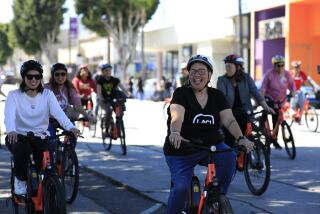Portland Art Museum’s ‘Cyclepedia’ spins a tale of the bicycle
To Michael Embacher, the bicycle is a beautiful blend of form and function. “I’ve always been inspired by its brilliant ingenuity,” he says. “How it efficiently transforms human energy into maximum mobility and how this translates into design.”
The Vienna-based architect and designer finds bikes so inspiring that he has collected about 220 of them — including classics, prototypes and novelties clever and curious. Forty of his wheeled wonders are making their U.S. debut in an exhibition at the Portland Art Museum in Oregon through Sept. 8.
Bruce Guenther, the museum’s chief curator, says “Cyclepedia: Iconic Bicycle Design” traces the evolution of the versatile vehicle, which was developed in the 19th century: “We see it go from transportation to sport and recreation, from two wheels and a handlebar to something that looks like a rocket and performs like a Mercedes.”
FULL COVERAGE: 2013 Spring arts preview
Included are racing, tandem, touring, folding, cargo and recumbent models. One is outfitted with a front skate blade so it can cross frozen surfaces; another was dropped by parachute during World War II. The earliest piece, a 1925 Cycles Hirondelle Rétro-Direct, came from France as did the most expensive, a rare ‘30s-era Schulz Funiculo. “The constructor Jacques Schulz was a master innovator,” Embacher says. “I paid the amount of a well-equipped middle-class car [for it].”
Embacher, 50, started collecting about a decade ago when he began buying used bicycles on the Internet after suffering several thefts. “It’s not about looking at objects but using them,” he explains, adding that he has ridden each of his treasures.
The museum’s interest in an exhibition was prompted by a 2011 book featuring the collection, which has also been displayed in Austria. Guenther and Embacher are the co-curators; Embacher designed the installation.
CRITICS’ PICKS: What to watch, where to go, what to eat
The subject is a natural fit, given Portland’s reputation as a bicycling hub. Indeed, during “Cyclepedia,” local designers and collectors are being spotlighted in the lobbies.
In a more offbeat example of community outreach, Guenther says that when he and his colleagues realized the show’s opening coincided with “the annual World Naked Bike Ride here, we decided to open the museum at night and welcome them. We charged $1 per piece of clothing, not counting shoes.”
Guenther estimates that 1,000 people attended. “And let’s just say a lot of them got in free.”
More to Read
The biggest entertainment stories
Get our big stories about Hollywood, film, television, music, arts, culture and more right in your inbox as soon as they publish.
You may occasionally receive promotional content from the Los Angeles Times.






